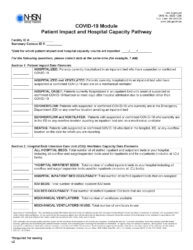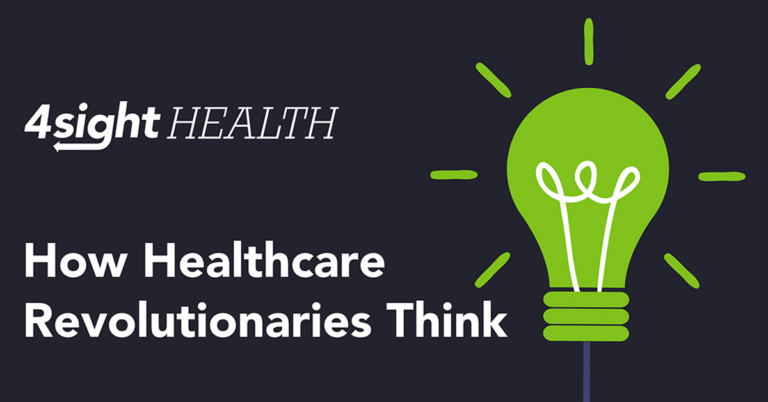May 5, 2020

Better Data. Better Outcomes. Moving Toward a National Health Information Exchange
Key Takeaway:
- A national Health Information Exchange (HIE) will be an invaluable tool for federal, state and local public health officials fighting to protect Americans from the COVID-19 and future pandemics.
- The software and standards for exchanging data – the building blocks for implementing a national HIE – already exist and are in use in many states and regions.
- Protecting patient privacy – a major concern – is doable. The same penalties that now apply to misuse of patient data can be applied to a national HIE.
- Health IT leaders say a national system can be fully functional in 2020.
- Federal leadership is necessary to get the job done.
To end the COVID-19 pandemic, public health officials need immediate access to individuals’ testing and case data. Without it, they cannot accurately track the novel disease’s incidence or trace its potential spread.
Tracking and tracing are vital tasks if the nation is going to fully reopen its economy without triggering a second pandemic wave.
Right now, state and local health departments across the country labor under a patchwork quilt of COVID reporting systems, ranging from the fully automated to old-fashioned paperwork. Their jobs would be a lot easier if they had access to a nationwide health information exchange (HIE) that knit together the nation’s fragmented electronic health record system.
Such a national HIE doesn’t exist today. But health IT experts, many with decades of experience, say it could be built within a matter of months, since the technology and standards for construction already exist. Yet, the federal government refuses to use its emergency powers to assemble a national HIE.
Dr. Donald Rucker, the nation’s top administrator for health information technology, says it’s not as easy as these healthcare industry experts claim. He rejects using the national emergency to compel health care providers and their electronic health record vendors to act while they’re busy fighting the pandemic.
“A number of vendors will say, ‘oh yeah, we have this. But somebody has to format the data into our way of doing it. Then we have no problem doing it,’” says Dr. Donald Rucker, who heads the Office of the National Coordinator inside the Health & Human Services Department. “That just puts the complexity on somebody else. Somewhere, the hard work has to be done.”
In other words, despite a raging pandemic, nothing has changed in the federal government’s long-running refusal to force healthcare providers and their vendors to collaborate in exchanging health information. Indeed, last month, HHS postponed the enforcement of new rules promoting connectivity scheduled to go into effect in January 2021. Governor Andrew Cuomo in New York issued a similar delay order.
Dr. Siddhartha Mukherjee, writing in the May 4, 2020 issue of the New Yorker Magazine, drew a painful conclusion about the nation’s decade-long, multibillion-dollar investment in health information technology: While fighting a pandemic, “a system designed to expedite and improve the delivery of healthcare was officially recognized as an obstacle.”
Why America Needs a Federal HIE
Ideally, a well-designed national HIE would provide public health officials at the federal, state and local level with vital COVID-19 data:
- patients’ geographic and demographic data;
- treatments and tests results;
- the use and availability of hospital beds and medical supplies.
This data would give officials up-to-the-minute feedback on their desperate efforts to combat and contain the disease. It would aid enormously in efforts to test, track and trace people who may have been exposed to the coronavirus.

Health experts say a comprehensive system for testing, tracking and tracing the disease is essential for America to emerge quickly from the worst economic crisis since the Great Depression.
Without instant access to data, state and local officials will be hard pressed to know exactly where to deploy scarce resources. Without a high-functioning health information exchange, the national effort to contain the coronavirus could fail.
Over the next several weeks and months, government leaders will face increasingly strident demands from a financially desperate public to resume normal economic activity. Some states and localities may lift shelter-in-place orders prematurely. Incidence of the disease, which is taking its most horrendous toll on the nation’s senior citizens and minority communities, could resume growth. Come fall, the nation could be facing a second shutdown.
The Centers for Disease Control and Prevention, and other federal agencies, are not communicating the information state and local officials need to avoid this disastrous scenario. The CDC relies on an antiquated surveillance system that uses incomplete surveys, often reported manually by the states, to track cases and overall mortality.
After stumbling off the block, testing for COVID-19 and its antibodies remains spotty, and there is no central database of results. Widely-deployed electronic health record systems – the fruits of a $30 billion-plus taxpayer investment – have played almost no role in pinpointing new cases and hot spots, determining best treatments, or identifying the populations most at risk of contracting the disease.
These shortcomings are painfully apparent. Responsible public health experts warn that the prevention of future lockdowns will depend on: widespread testing; the rapid identification and isolation of new cases; and a comprehensive system for tracing, tracking and testing people with possible exposure. A national health information exchange (HIE) would dramatically improve the nation’s ability to carry out those tasks.
The software, data standards and automated information-sharing protocols needed for a national HIE already exist. Forward-looking states and metropolitan areas are already following these protocols to track new and existing cases and deaths. Hospitals in some areas already rely on these tools to provide daily updates on the use and availability of hospital beds, ICU beds, ventilators and personal protective equipment.
In other words, the building blocks for a national system that can extend those benefits to every corner of the country already exist. What’s missing? The will to use them, and leadership at the national level.
Washington States Illustrates HIE’s Potential
Washington state has operated an effective HIE for almost a decade. Washington was the first state with confirmed COVID-19. The HIE generated daily updates on new cases, deaths, testing and results. State officials say it played a key role in slowing the disease’s spread.

“The HIE is giving us the surveillance tools we need to monitor and respond to the pandemic,” said Dr. Bryant Thomas Karras, the chief informatics officer for the state Department of Health. “The information is automated. As facilities became busy and occupied in responding to the crisis, there was no manual intervention. The data we needed just flowed in.”
Unfortunately, there are some significant gaps in the state’s data. Nursing homes, behavioral health providers and long-term care facilities never received funding from the government to install electronic health records (EHRs). Many do not have the technology needed to participate in the system.
Federal grants from the 2009 Health Information Technology for Economic and Clinical Health (HITECH) act initially funded the state’s HIE. That legislation funneled over $30 billion to hospitals and physician practices to adopt EHRs.
The purpose of the relatively small HIE grants was to fund the creation of state and regional exchanges to empower patients and their providers with instant access to their complete, consolidated patient record from multiple locations. HIE proponents yearned for frictionless portability of records (interoperability) to eliminate duplicative test and procedures; facilitate marketplace competition; and provide a powerful tool for tracking diseases and conducting research.
Unfortunately, the HIE grants expired five years ago in one of the Republican-controlled Congress’ moves to constrict spending during the Obama years. The Washington state system, like the 70 others that still exist across the country, applies user fees paid by participating hospitals and physician practices to fund operation. Most regional HIEs failed to elicit widespread support from healthcare providers and EHR vendors in their regions, and thus never reached their full potential.
On the other hand, Washington state and a few other states and regions did manage to win local backing. All hospitals in Washington, with the exception of two rural facilities that are just now getting on board, belong to the system, as do all the major physician practices. Their daily data uploads go directly to the public health officials managing the state’s pandemic response.
“In some states where the HIE failed, the departments of health have to do all the work themselves,” Karras said. “All my colleagues working in public health across the country are doing the best they can with the resources they have available.”
Budget-cutting isn’t the only reason the HIE dream withered. Healthcare providers and the EHR vendors have a financial stake in blocking information sharing. They worked behind the scenes to prevent implementation.

Why would they do that? Because no hospital or physician practice wants to see their patients visit a different provider to get lower-priced services, something that would be much easier if patients have ready access to their medical records.
None of the EHR vendors want their software to use a common standard for information sharing. That would turn their products into commodities, force the EHR companies to compete on price and service quality and open the door to more competition.
Too often these private interests trumped the public good. Even in the midst of this national emergency, the proprietary forces are playing “deflect and delay” to postpone information sharing. Responding to provider pleas, on April 21, 2020, the Centers for Medicare and Medicaid Services told hospitals they needn’t worry about enforcement of the new interoperability rules adopted just six weeks earlier when the pandemic was still gathering speed. “In a pandemic of this magnitude, flexibility is paramount,” said HHS Secretary Alex Azar. “Our action today will provide hospitals an additional six months to implement the new requirements.”
Health IT experts said they should be moving in the opposite direction. It’s already a non-issue in regions with strong HIEs. San Diego’s Health Connect, which, like Washington state’s HIE launched in 2010 with federal grants, used widespread buy-in by local health care providers to build a strong, fee-based exchange that covers the two southernmost counties in California.
All public, private and military hospitals in the San Diego region (with the exception of two community hospitals owned by Prime Healthcare) funnel data through the system. The region’s large physician practices and 15 of the 18 federally qualified health centers also belong. Most mental health, substance abuse and post-acute care providers are not part of the system.
Health Connect isn’t a repository of health records. On the platform, individual providers can immediately pull a patient’s complete record populated with information from all participating providers. The system has proven extremely valuable in providing timely access to medical data. For example, ambulance technicians and emergency room physicians gain instantaneous access patient records during transport to hospitals.
The San Diego exchange suffers from many of the same shortcomings as Washington state’s HIE. But it was well prepared for responding to the COVID-19 pandemic after spending nearly four years encouraging providers to use the right codes for influenza cases.
When COVID-19 first appeared, the San Diego exchange immediately sent a new code to all providers to ensure they accurately reported the new disease in their EHRs. Public health authorities used the system to collect daily reports on 95% of all coronavirus cases in the region. The two non-reporting hospitals account for the other 5% of cases.
“We can even report on beds, ICU use and ventilator use through this, but we’re not doing it today,” said Daniel Chavez, executive director of San Diego Health Connect. “Right now, that’s a manual system. Someone from each hospital has to go into the county system, log on, and report daily. We could get that information because it all flows through the EHRs. We just have to go grab it.”
The Nation’s Broken HIE Backbone
New York City and some other hard-hit cities have experienced severe hospital bed and ventilator shortages. Governors in states that suffered the first major hits from the pandemic have issued desperate pleas for help.
The federal government dragged its feet despite nearly half the states’ and nation’s hospitals having an electronic data reporting system, once called HAvBED, to track the use of hospital and ICU beds, the availability of personal protective equipment and other vital information. Set up in the wake of Hurricane Katrina, HAvBED helps regions cope with sudden surges in demand for hospital beds.

Unfortunately, none of that information flows into a national exchange that a federal agency could use to coordinate the national response to COVID-19. In the fall of 2016 HHS suspended the National Hospital Available Beds for Emergencies and Disasters (HAvBED) program. Twenty-two states still use the program’s software that Atlanta-based Juvare, LLC, a private equity-backed firm, developed. Federal Emergency Management Agency also uses its software when it responds to natural disasters.
“Not only do the hospitals use the system to manage beds in a crisis, they pivot to use it for everyday purposes,” said Sam Klietz, chief client officer for Juvare. “It lets them know what’s in use on any day, at any time. 911 systems use it. In essence, you have a network that connects every hospital into one system.”
As the COVID-19 crisis escalated, hospitals added new categories like PPE and ventilator availability to their reports. Some added case reports and mortality data.
On March 29, the federal COVID-19 task force headed by Vice President Michael Pence asked hospitals to voluntarily report bed, ventilator and other information through the CDC’s hospital safety reporting system. The letter linked to electronic spreadsheets or printed forms for collecting data. “Why is the CDC making hospitals jump through these antiquated hoops,” Klietz asked. “We’re already collecting capacity data.”

Robert Watson, Juvare CEO
“I’ve been in the health care IT space for 40 years. I talk to the Cerner, Epic, Allscripts (the three largest EHR vendors) guys all the time,” Juvare CEO Robert Watson said. “All of us would like to participate (in a national system). But there is no single point of contact. There are competing groups inside the White House. There are competing federal agencies. There is a complete lack of leadership. A vendor can’t be the leader until somebody at the top says so,” he said.
When contacted, the major EHR vendors claimed they are making their proprietary systems available to the government officials in charge of curbing the pandemic. A spokeswoman for Epic said its 400 hospital system clients have agreed to share data in a standardized way.

Source: CDC website, accessed May 1, 2020. https://www.cdc.gov/nhsn/pdfs/covid19/57.130-covid19-pimhc-blank-p.pdf
Epic says it will use de-identified data to analyze which demographic groups are most susceptible to COVID-19, how pre-existing conditions affect its severity, and the efficacy of various drugs and treatment protocols. “We’re making summaries of the data available to state and federal public health agencies and our customers,” the spokeswoman said.
Cerner officials offered a different excuse for vendors’ unwillingness to pull together a common case tracking system. “There are marketplace forces in place that don’t want to share this data nationwide on a peacetime basis,” said Ryan Kreinbring, the company’s vice president for government services. “Hospitals don’t want their competitors to know their capacity.”
“There’s no nationwide COVID-19 surveillance system,” said Dr. Anand Parekh, chief medical advisor to the Bipartisan Policy Center in Washington. “Every positive test should go into a national database so you could have a map that in real time, whenever there’s a case, lights up. We don’t have that granular data. Some states may have something,” he said. “But there’s no system.”
A national HIE is the only thing that can ensure that every state has the capacity to trace potential exposures and end the COVID-19 lockdowns safely. As things stand now, the private sector has proven itself unwilling or incapable of taking the lead. It’s time for the federal government to lead its creation.
Protecting Privacy
Backers of a national HIE must address widespread fears that such a system will forfeit patient privacy. Hospitals and physician practices that link their records to regional, state or national exchanges need assurances that shared data won’t leak out, or that anyone with legitimate access to the system’s data won’t use it for unintended purposes. Violations of the patient privacy protections in the 1996 Health Insurance Portability and Accountability Act (HIPAA) can range into the millions of dollars.
The HIPAA rules state that providers “must make reasonable efforts to ensure that access to personal health information is limited to the minimum necessary to accomplish the intended purpose of a particular use, disclosure, or request.” In this case, the intended purpose is control of the pandemic, a clear national emergency. Provider organizations have inundated state and federal health departments and the HHS Office of Civil Rights, which enforces HIPAA, with requests for clarification on what data can and cannot be shared.
“The rules are very clear,” said Mariann Yeager, the CEO of the Sequoia Project, that has advocated for a national HIE since its formation in 2012. Any federal agency “has to assert that they’re asking for information that is minimally necessary, even in a pandemic.”
With the help of a small federal grant in 2014, a small Maryland-based firm called Audacious Inquiry helped California develop software that can pull the medical records of displaced people seeking care in shelters after forest fires. In recent years, it has worked with the Sequoia Project to expand the program into the Patient Unified Look-up System for Emergencies (PULSE), that could become part of the backbone of a national network.
In a late March 2020 letter, Audacious Inquiry president Scott Afzal asked Vice President Pence, presidential advisor Jared Kushner and the leaders at HHS to support a nationwide approach to reporting hospital capacity, lab testing results and other critical data points. The firm said the rollout of what it dubbed The Situational Awareness for Novel Epidemic Response (SANER) project could begin in four months with federal help.
“This work can be instrumental for long-term use in future disasters and public health emergencies. It would create the infrastructure required for real-time data sharing from clinical settings to local, state and federal public health authorities,” Afzal wrote.
Sequoia Project’s Yaeger said HHS’ Office of Civil Rights could issue a simple amendment to its privacy guidance that would relieve providers of their privacy concerns. She’s even prepared the language: “During the duration of the COVID-19 Public Health Emergency, the submission of a C-CDA (the consolidated clinical document architecture, the common standard for sharing EHR data) electronic document or related electronic data will meet the minimum necessary threshold for a public health disclosure.”
“Providers aren’t responding to requests for records because they think it would be a violation of HIPAA,” she said. “It’s not a violation if they can rely on it being the minimum necessary.”
So far, HHS hasn’t responded. “To do this work in the midst of a pandemic is very challenging,” Yaeger said. “The best time to prepare is before the crisis.”
The HIE Payoff
Building a national HIE over the next several months will pay huge immediate and future dividends, and not just in better preparation for the next pandemic. It would be an enormous aid to payers and providers pursuing ongoing population health management strategies. Its de-identified data would help determine best clinical practices, the efficacy of off-label drug use and negative/unwanted side effects.
And, as more providers begin entering their patients’ food, housing and transportation needs into medical records, government officials at all levels will have a better handle on where and how to address the social determinants of ill-health in our society.
“There is not a technological hurdle to getting this done,” said Juvare CEO Watson. “The vendors are pretty smart. Together we know how to do this. We’re not competitive on this particular subject. We’re all willing to work together. There’s just no leadership.”
An earlier version of this article incorrectly identified the source of Pulse, the data exchange created for California in 2014. It was Audacious Inquiry.
To read more articles about COVID-19, please click here. Or, join over 5k+ revolutionary healthcare leaders who read 4sight Friday here.





